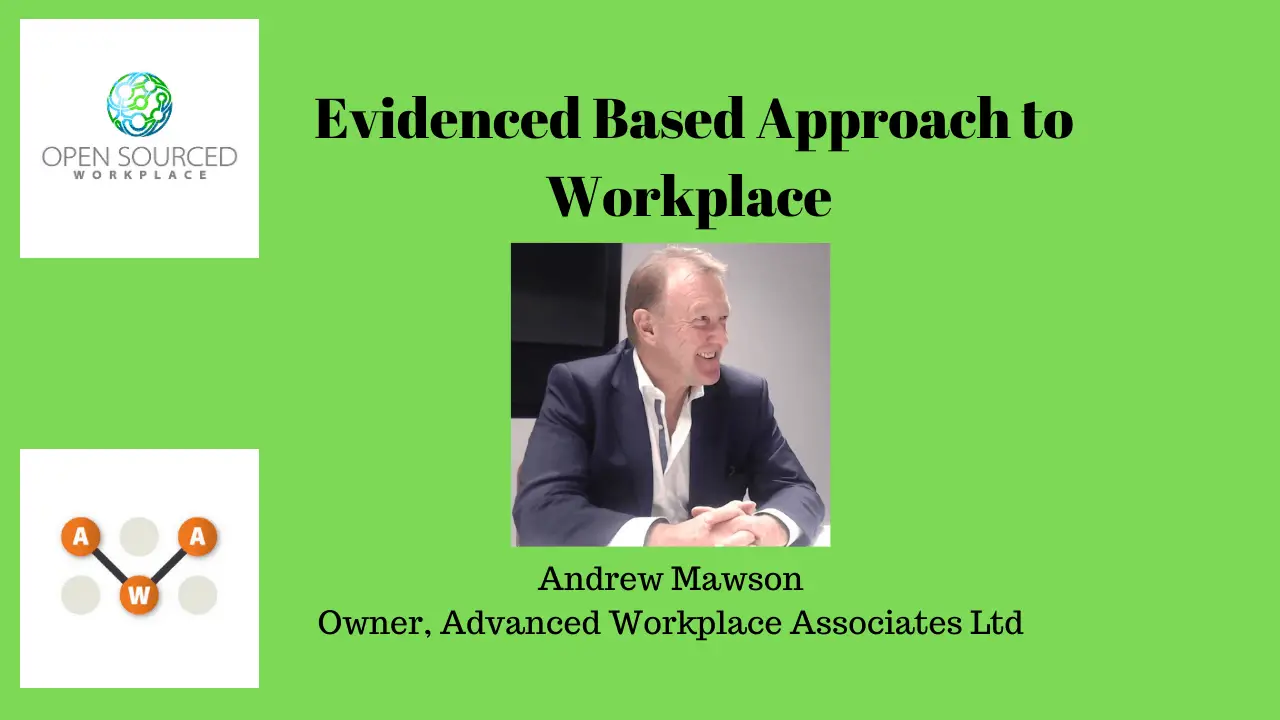As the Managing Director of Advanced Workplace Experience, Andrew Mawson is a wealth of knowledge on all things workplace. With a beginning in IT and intelligent buildings, Andrew found himself in the world of workplace. He then found himself benchmarking on the topic of workplace agility and mobility and moved into consulting from there.
is a wealth of knowledge on all things workplace. With a beginning in IT and intelligent buildings, Andrew found himself in the world of workplace. He then found himself benchmarking on the topic of workplace agility and mobility and moved into consulting from there.
(Have you worked with Andrew Mawson – provide a quick review – Click HERE )
)
His past experiences and professional journey have gained Mawson the knowledge that he brings to the table. He discusses knowledge workers, neuroscience in the workplace, managing an agile workforce, making change possible, and productivity in a recent interview for Open Sourced Workplace. With Andrew Mawson’s shared information, companies will likely find themselves far more prepared for change and agile workforces.
What Factors Most Impact Knowledge Workers?
Andrew Mawson has played a role in various studies that lead to various components of factors that impact knowledge workers. In conjunction with the Center for Evidence-Based Management, Advanced Workplace Experience did research that provided answers, but it had to be translated into a language that was easily understood. However, it can’t stop there. The research and answers must then have an action that gives practical guidance.
What guidance has stemmed from research? Knowledge-based communities, the human brain, and managing an agile workforce are three factors that have a large impact on workers.
What is a knowledge-based community? Simply put, a community of this nature is one that makes it a priority or goal to share knowledge. Knowledge ties directly in with the human brain. The human brain impacts workers because of the need to protect itself, in spite of its ability. These two components, along with managing an agile workforce impacts knowledge workers in more ways than one.
Workplace and Neuroscience
Knowledge workers are human just like any other person. This means they have a brain and many of the same instincts that any other worker might have. However, many fail to see the importance of neuroscience considerations in the workplace. Understanding the importance of tying the two together can help workers and companies in a variety of ways.
As infants, humans have brains that have not been programmed. As they grow and develop, cultures and specifics are taught and learned. Since the brain is a learning machine, people learn both consciously and subconsciously. Ultimately, the brain wants to keep you safe. This is not necessarily a learned behavior, but it is hard wired to take no risks.
With the adversity to change, the brain is resistant. Because of this, the change should be a process that allows the brain to understand the change. It is the job of the organization to help worker’s brains to accept the change. It requires an explanation and a deep understanding of what is happening and why. An easier transition allows the brain to move forward without reverting back to its old ways.
What Matters When Managing an Agile Workforce?
An agile workforce is one that allows knowledge workers to use their skills and talents to the best of their ability. Rather than being confined to a specific role, an agile workforce allows individuals with multiple talents to put them to use. The question then arises: how do you manage this kind of workforce?
Having an agile workforce requires managing the individual, not a department or role. Where many organizations fail to see workers as people with personalities, an agile workforce requires it. Research is key. Understand the people and their brains to manage them effectively.
Changing Tribal Behavior
When it comes to changing culture in the workplace, organizations are really changing tribal behavior. The problem with this is that senior leaders do not often have the knowledge required to make such a change. When a culture is built solely from the top down, it can easily be misconstrued or not communicated to lower members of the team.
Communicating from the top without ensuring the comprehension at lower levels is a mistake many companies make. Upper-level workers must understand how others communicate and understand those communications.
Proper communication means that everyone must be involved in learning about change and tribal behavior. Doing this often requires change agents – workers from various levels that are more open to change and ready to help those that struggle.
Managers Misunderstanding Awkward Questions
Mawson thinks that many feel as though questions are asked to managers because they are not liked. In reality, all good questions and answers are what is needed to get prepared for change. Although managers might dislike the idea of being asked good questions, understanding those questions is necessary to communicate the correct information to ready employees for change.
The lack of understanding between lower-level employees and managers can cause a lot of problems that make change harder than necessary. In the midst of a transition, managers must see good questions for what they are: an attempt for workers to better understand the change. Without this understanding, the brain will struggle even more so with the transition than it should.
Measuring Productivity in Knowledge Workers
Andrew’s company has developed a tool that measures behavior and person preferences, in addition to space and technology. They have an idea of what is needed and then measure the responses of workers. For knowledge-based communities, research is the most important thing. Mawson also says that being friendly with employees is a metric that can offer a lot of information.
Developing a community within the workplace is simple – organizing events, networks, and similar things allow for the ability to communicate with others and understand what they’re saying. When people are given the opportunity to talk, many will do so. Without a community that allows this kind of interaction, a lot of things are not being shared.
How to Maximize Productivity and Experience
Hierarchy is not something that adds to productivity or workplace experience. Developing a company culture that avoids this kind of division allows more of a community feeling. An environment that allows for things to be easy is one that encourages productivity and positive workplace experiences.
Ensure that employees are comfortable and able to be themselves. Achieving that works wonders on overall improvement in both areas.
Watch the full interview – Click the image below
Related Questions
What is a knowledge worker? A knowledge worker is a person that bases his or her profession on information. The understanding of various facts, information, and knowledge, in general, is central to their career. These individuals think for a living.
What is tribal behavior? Tribal behavior is much like what it sounds like: how a group of people act. Whether learned from a young age or influenced by those around you, a tribal behavior is how you’ve been taught to behave.
Check out other Topics:
Coworking , Technology
, Technology , Stress
, Stress , Wellness
, Wellness , Sustainability
, Sustainability , Workplace Productivity
, Workplace Productivity , Employee Experience
, Employee Experience , Hot Desking
, Hot Desking .
.
(Sign up for Audible and get TWO audiobook for FREE – click here)
Watch Book Review Animated Videos on Open Sourced Workplace – CLICK HERE
Join the Open Sourced Workplace Community




